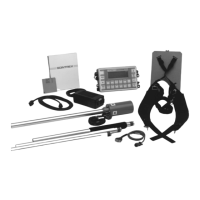Applications
B3-12 ENVI-MAG Manual
Data transfer
It is a good procedure at the end of each survey day to transfer the data acquired
during the day. You can keep the equivalent of two days’ data for a typical
environmental survey in the magnetometers’ memory, but it is not considered
good procedure. The instructions to transfer (or dump) the data are explained in
the operations manual starting on page A6-10.
The data can either be dumped on a line-by-line basis or as an entire data set. You
would normally perform a line-by-line dump, if you intended to produce
individual profiles. Alternatively, you would do an entire data dump, if you
intended to produce a contour map.
Processing data
Once the data is dumped, you can perform many procedures to enhance the
presentation of the data. Data can be presented as contour maps or as profiles of
the measured values. In the case of multiple grids it is recommended that
processing be done for each grid separately. You will have to manually edit your
data file into separate data files for each grid.
The steps to producing a contour map or individual profiles are well explained
in the third section of the manual on the ENVIMAP software.
Further processing of the data can be carried out using the optional GEOSOFT
map processing software. This optional software allows you to create colour
plots, image maps and 3-D presentations, as well as providing enhanced gridding,
modelling and interpretation tools. Contact your SCINTREX representative for
more details.
Field example
Columbia test site — Waterloo, Ontario
The Columbia test site is located on the grounds of the University of Waterloo, in
Waterloo, Ontario, Canada. Three different types of targets are buried at this site:
45 gallon steel drums, pipes and sheets of metal. These targets are buried at
different depths and in different groupings. A sketch map of the Columbia test site
is shown in the following figure (Figure B-26).

